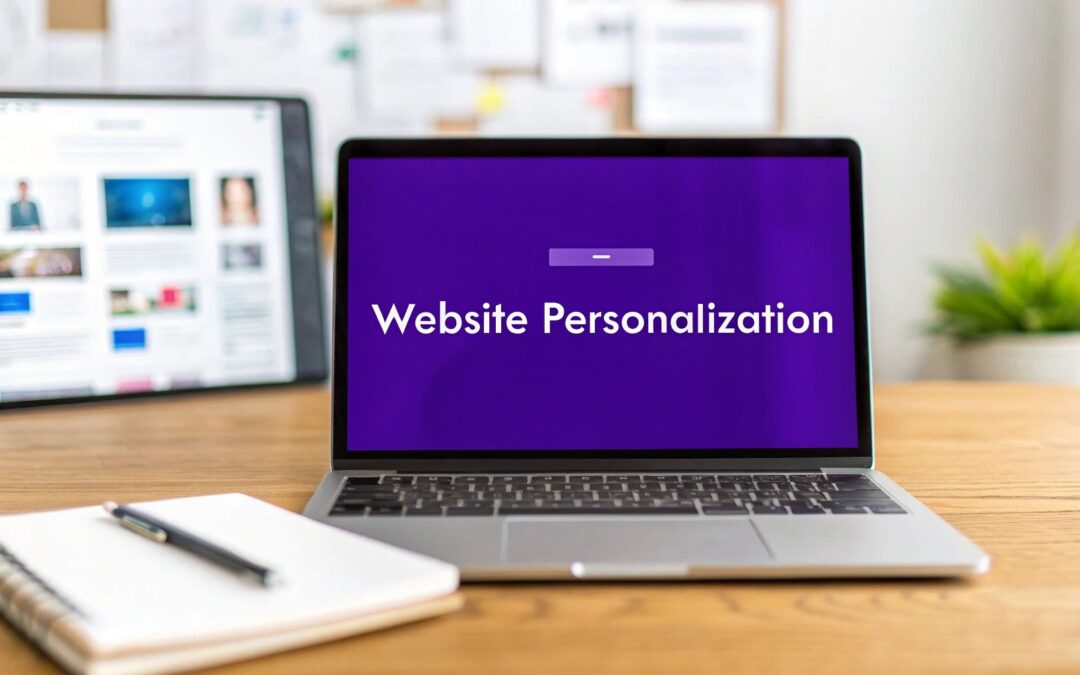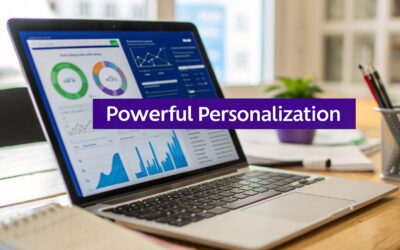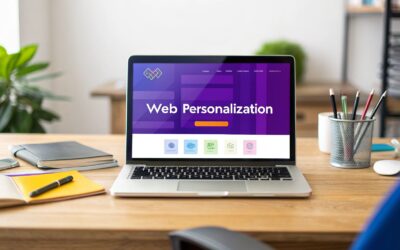Website personalization is all about creating custom-tailored experiences for your visitors. Instead of showing everyone the same generic page, your website dynamically changes its content, offers, and messages based on who is looking at it. It adapts in real-time based on their behavior, location, and history, making each person feel seen and understood from their very first click.
The Power of Personalized Digital Experiences
Think about walking into your favorite local coffee shop. The barista probably greets you by name, knows your usual order, and might even ask how that project you were working on went. That small, human connection makes you feel valued, turning a simple transaction into a memorable experience.
That’s exactly what website personalization brings to the digital world. It’s the difference between a static, one-size-fits-all brochure and a dynamic conversation that speaks directly to each visitor.
This strategy goes far beyond just having a "Hi [First Name]" field. It taps into visitor data—like their location, browsing history, or past purchases—to tailor everything they see. A brand-new visitor might get a welcome discount, while a loyal, returning customer sees product recommendations based on their last order.
Why Personalization Is No Longer Optional
In an online world overflowing with noise, a relevant and memorable experience is what makes you stand out. Personalization is the key to forging stronger customer relationships and, ultimately, driving better business results. The numbers don't lie: an incredible 89% of U.S. businesses saw a revenue spike after implementing personalization on their websites or apps. This shows a direct line between tailoring the user experience and boosting the bottom line.
At the end of the day, it's about making your audience feel like you get them. The core benefits are hard to ignore:
- Improved User Engagement: Relevant content keeps visitors on your site longer, clicking and exploring more.
- Higher Conversion Rates: When you show someone the right offer at the right time, they're far more likely to buy.
- Increased Customer Loyalty: A positive, personalized experience is a powerful reason for customers to come back again and again.
At its core, website personalization is about treating each visitor as an individual, not just another number in your analytics. It's the art of delivering the right message, to the right person, at precisely the right moment.
To really dig into what this process involves and the impact it can have, you'll want to explore the principles of Mastering Personalization on the Web. This isn't just another marketing trick; it's a fundamental shift in how businesses can connect with their audience online, building trust and driving real, sustainable growth.
How Website Personalization Actually Works
Ever wonder how a website seems to know exactly what you want to see? It’s not magic, though it can feel like it. It's a surprisingly logical, three-step process that turns a one-size-fits-all site into a personal welcome mat just for you.
Let's break down how this technology works, stripping away the mystery to show its simple and powerful core.
It all starts and ends with data. Think of your website as a detective gathering clues to understand a visitor's habits and what they're looking for. Websites collect these clues in two main ways:
- Explicit Data: This is the information visitors give you directly. When someone creates an account, fills out a form, or you see their complete purchase history, that’s explicit data. It’s the most straightforward and valuable information you can get.
- Implicit Data: This is the information you gather by observing behavior. It’s the digital body language of your visitors—the pages they visit, the products they click on, their location, the device they're using, and even the social media post that brought them to your site.
This process hums along quietly in the background, building a profile of who each visitor is and what they’re likely interested in.
The Art of Segmentation
Once your website has collected enough clues, the next step is to make sense of it all. This is where segmentation comes into play. Instead of trying to talk to a massive, faceless crowd, segmentation groups visitors into smaller, more meaningful audiences based on shared characteristics.
This grouping allows you to stop shouting generic messages and start having relevant conversations. In fact, a crucial part of any personalization strategy involves creating effective buyer personas to truly understand what makes these segments tick.
For example, a site might create segments like:
- First-time visitors from New York
- Returning customers who have purchased hiking gear
- Mobile users who abandoned their shopping cart
- Visitors who clicked through from a specific Instagram ad
Each segment represents a unique context. Understanding that context is the key to delivering an experience that resonates. Without segmentation, all that data is just noise.
Dynamic Content Delivery
With your visitors neatly sorted into segments, this is where the action happens. The website can now deliver the right content to the right group at the right time. This is called dynamic content delivery, where elements on a webpage—like text, images, or offers—change automatically based on who is looking.
Instead of one static homepage for everyone, the site might have dozens of variations ready to go. The infographic below shows this journey from a generic visit to a personalized one.
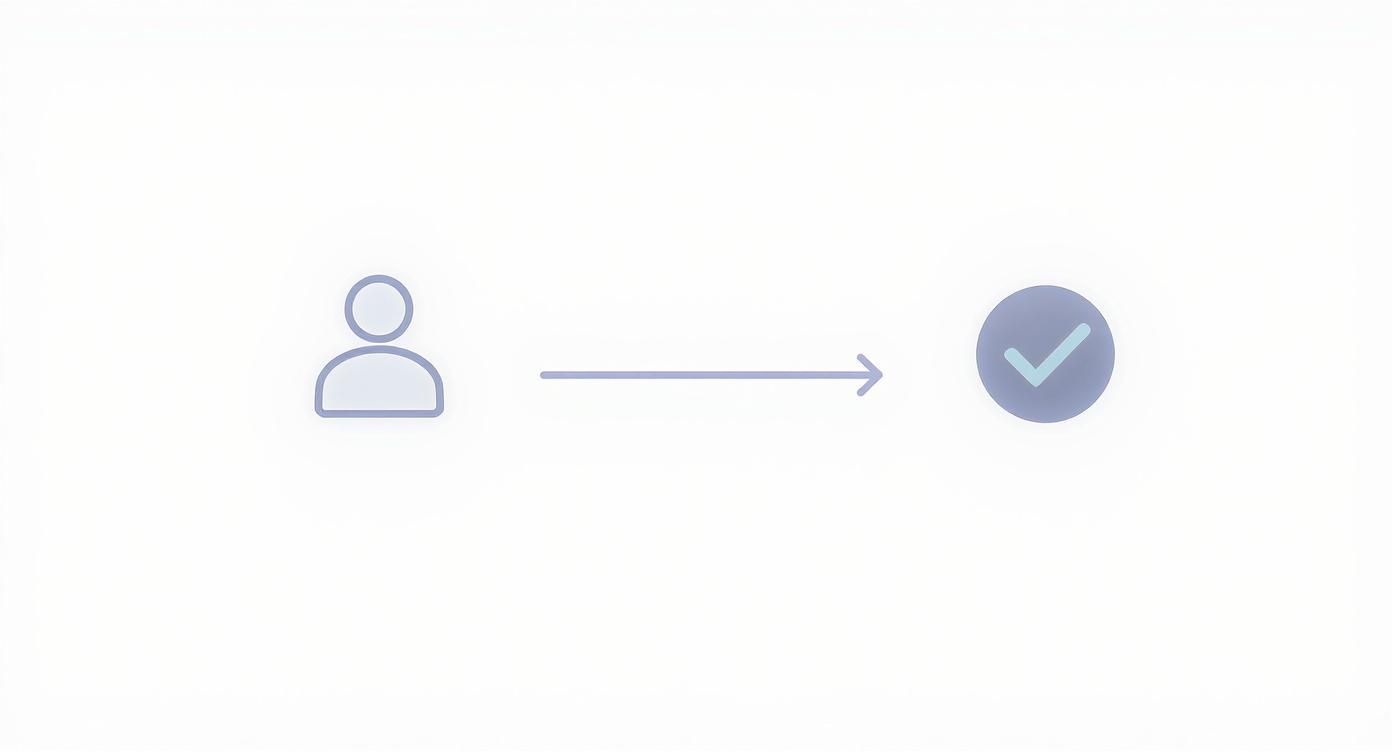
As you can see, the system identifies the visitor, matches them to a segment, and serves up a relevant experience designed just for them. To see how this comes to life in a Divi environment, check out our guide on how to use Divi dynamic content.
The goal isn't to create an entirely different website for every single person. It’s about making smart, targeted adjustments—like changing a headline, swapping an image, or promoting a specific sale—that make the experience feel uniquely relevant.
For instance, a visitor from a cold climate might see winter coats featured on the homepage, while someone browsing from a tropical region sees swimwear. A returning customer could be greeted with a "Welcome back!" message and recommendations based on their last purchase.
This simple three-step cycle—data collection, segmentation, and delivery—is the engine that powers truly effective website personalization.
What Personalization Actually Does for Your Business
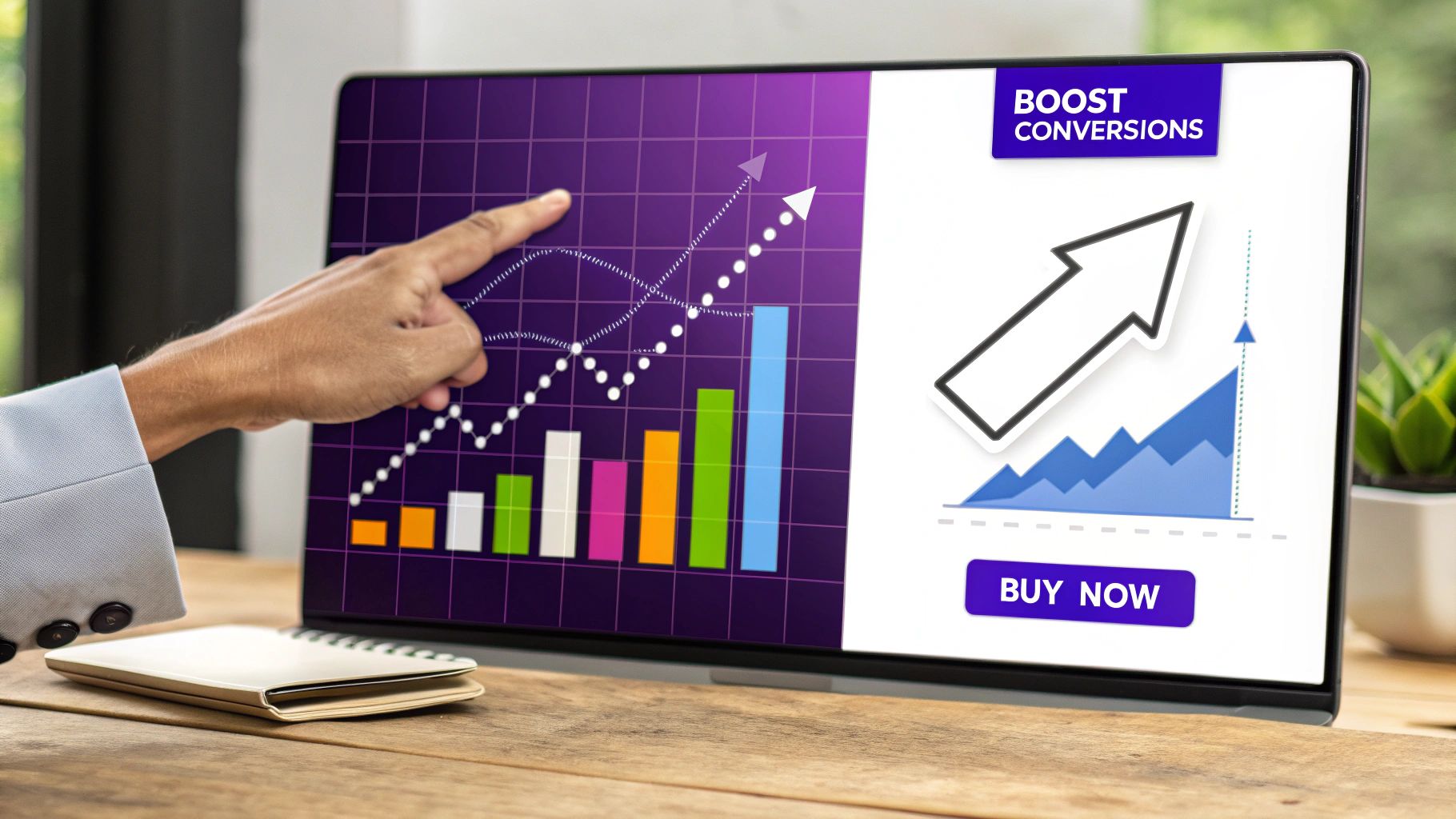
It’s one thing to talk about personalization in theory, but what does it really do for your bottom line? Let's get straight to the point. A smart personalization strategy isn't just about making your site feel a little friendlier; it’s a direct investment in your business’s growth.
The impact goes far beyond buzzwords. It touches every important metric you track, from how long people stick around to how much they spend.
Think about it. When someone lands on a generic site that feels like it wasn't made for them, their first move is to hit the back button. Personalization completely flips that experience on its head. By showing content or products that match what a visitor wants, you create an experience that's instantly more engaging. That means lower bounce rates and more time spent exploring what you have to offer.
And that engagement is just the first domino to fall. A visitor who feels like you "get them" is way more likely to take the next step, whether that's signing up for your email list or pulling out their credit card.
Driving Conversions and Boosting Revenue
At its heart, personalization is an incredibly powerful conversion tool. It’s the difference between a good website and a great one.
Imagine showing a returning visitor from a cold climate your new line of winter jackets, while a first-timer who clicked a campaign ad sees the exact product that brought them there. That kind of relevance removes all the guesswork and friction from the shopping process.
By tailoring the journey, you’re not pushing a sale. You’re guiding visitors toward the solutions they were already looking for, making the path to purchase feel helpful and natural.
This isn’t just a nice idea—it’s what customers now expect. In fact, a whopping 74% of customers get frustrated when website content isn’t personalized. On the flip side, 57% of users are more than willing to share their data if it means getting a more relevant, tailored experience in return. You can check out more stats like these over at VWO.com.
Ultimately, all these small wins add up to a big impact on your revenue. Better engagement and higher conversion rates naturally lead to more sales and larger order values. For a deeper dive, our guide on how to improve website conversion rates is packed with actionable advice.
Building Lasting Customer Loyalty
Maybe the most valuable benefit of a great personalization strategy is its power to create real customer loyalty. A personalized experience does more than just sell a product; it shows customers you're paying attention and you value their business.
This creates a positive cycle that keeps people coming back:
- First Visit: A new visitor finds a relevant offer and makes their first purchase.
- Second Visit: They return and are greeted with a "Welcome back!" message and recommendations based on what they bought last time.
- Ongoing Relationship: Your website becomes their go-to spot because it consistently understands what they need, sometimes even before they do.
This kind of thoughtful engagement is what turns one-time buyers into repeat customers and, eventually, into loyal fans who rave about your brand. It transforms your website from a simple storefront into a powerful relationship-building machine.
Key Website Personalization Strategies and Examples
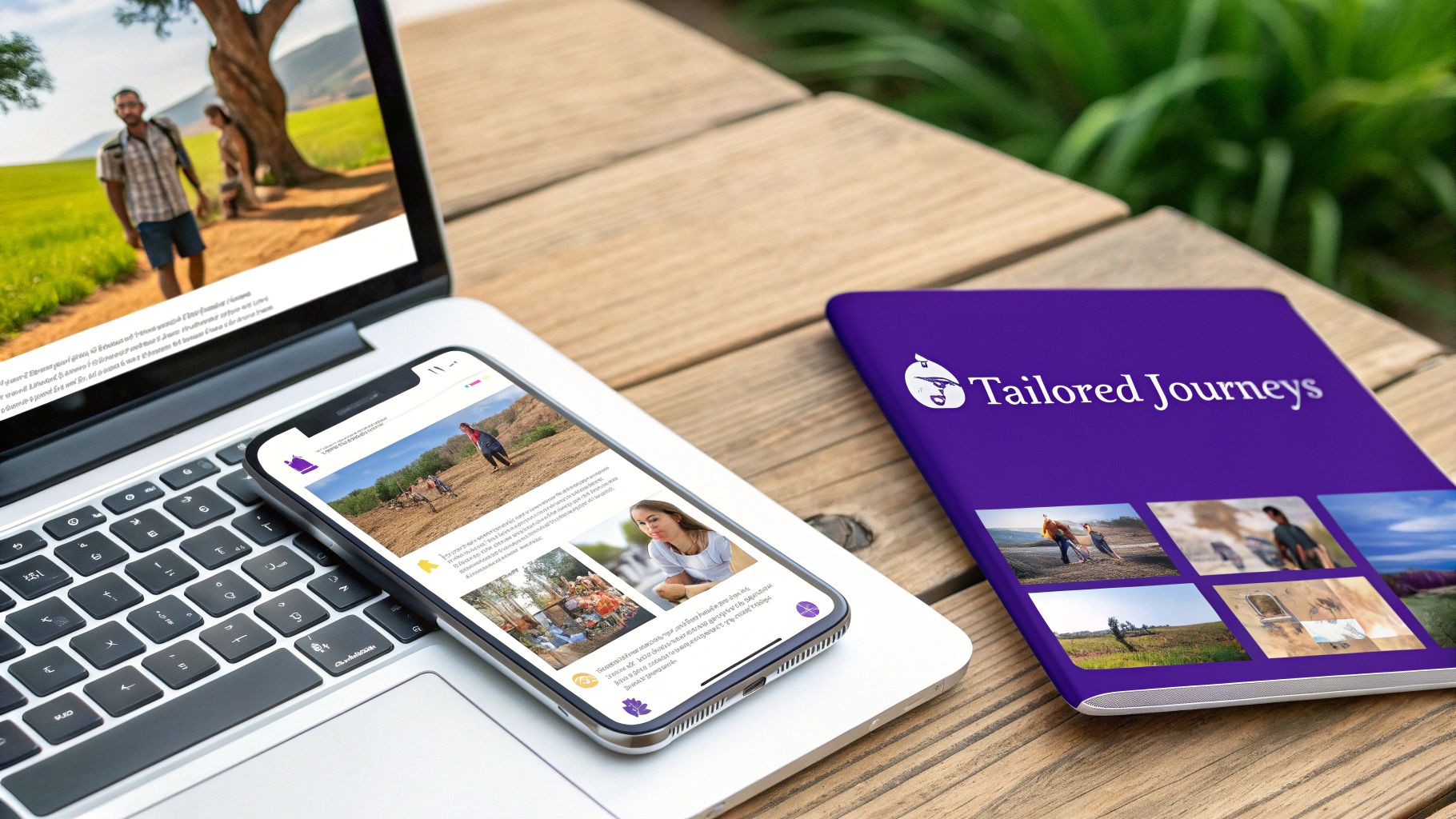
Knowing that personalization is powerful is one thing, but actually seeing it work is another. Let's shift from the "why" to the "how" and dig into the practical strategies that make website personalization a reality.
These are the techniques that create those jaw-dropping "how did they know I needed this?" moments for your visitors. The big idea is to use different bits of visitor data—from their location to their past clicks—as clues to deliver a far more relevant and helpful experience.
Tailoring Content Based on Geolocation
One of the simplest yet most effective ways to personalize is by using a visitor's geographic location. This strategy instantly makes your website feel more local and familiar, which goes a long way in building trust and reducing friction.
Imagine a national clothing retailer. If someone from sunny Los Angeles lands on their homepage in July, greeting them with a banner for heavy winter parkas is a complete miss. A personalized site, however, would use their IP address to detect their location and swap that banner out for summer dresses, beach gear, or promotions for a local LA store.
Here’s what you can do with geolocation:
- Localize Language and Currency: Automatically switch to the local language and show prices in the correct currency for your international visitors.
- Promote Regional Offers: Showcase sales, events, or products that are specific to a visitor’s city or state.
- Use Relevant Imagery: Ditch the generic stock photos and use images that reflect the local culture or landmarks.
This approach makes people feel seen and catered to from the very first click, creating a much warmer welcome than a generic, one-size-fits-all page ever could.
Segmenting New Versus Returning Visitors
You wouldn't talk to a complete stranger the same way you talk to an old friend, right? The same logic applies to your website visitors. A core strategy in personalization is creating two completely different journeys for first-timers and loyal customers.
A new visitor needs an introduction. They’re trying to figure out who you are, what you sell, and why it should matter to them. Your job is to guide them and make an unforgettable first impression.
A returning visitor, on the other hand, already gets it. They're back to see what's new, find things related to their previous interests, or just pick up where they left off.
Key Takeaway: The conversation with a first-time visitor is a handshake; the conversation with a returning visitor is picking up an ongoing dialogue. Personalization makes sure you aren't starting from scratch every single time.
This distinction allows for some seriously effective, targeted actions. For example, you could show a 10% welcome discount popup only to new visitors to nudge them toward their first purchase. For returning folks, you could greet them with a "Welcome back!" message and a curated list of "New arrivals since you were last here" based on what they looked at before.
Behavioral Personalization: The Ultimate Relevance Engine
This is where personalization gets really, really good. Behavioral personalization means tracking a visitor’s actions on your site—the pages they view, the products they click on, the items they add to their cart—and using that data to predict what they want and adapt their experience in real-time.
This is the secret sauce behind giants like Amazon and Netflix.
When Amazon shows you a "Frequently bought together" section or Netflix curates a "Top Picks for You" row, they're using your past behavior to serve up content that’s almost impossible to ignore. This doesn't just make the experience better for you; it's a massive revenue driver.
Examples of behavioral personalization in action:
- Product Recommendations: Displaying products related to items a user has already viewed, bought, or put in their cart.
- Content Suggestions: Highlighting blog posts or articles on topics a visitor has clearly shown interest in.
- Abandoned Cart Reminders: Gently reminding a visitor of items left in their cart with a subtle popup or banner as they browse other pages.
This strategy turns your website from a static brochure into a dynamic, helpful assistant that anticipates your user's needs. To see more of these tactics in the wild, check out these compelling website personalization examples from different industries.
Personalizing the Journey Based on Traffic Source
Knowing how someone arrived at your website gives you a ton of context about their intent. A visitor who clicks through from a Facebook ad for a specific pair of shoes is in a completely different headspace than someone who found you through an organic search for a broad term like "running gear."
By tailoring the landing page to match the referral source, you create a seamless journey that reinforces the exact message that brought them there in the first place.
For instance, if a user clicks an email promoting a "Summer Blowout Sale," the landing page they hit should have a hero image and headline that screams "Summer Blowout Sale." If they arrive from a guest post you wrote on a partner’s blog, you could display a small welcome message acknowledging that partnership. It’s a simple trick that builds instant trust and continuity.
This kind of alignment can dramatically boost conversion rates simply by meeting visitor expectations right out of the gate.
Personalization Strategy Comparison
To help you decide where to start, here's a quick breakdown of the strategies we've covered, what they're best for, and the kind of data you'll need to pull them off.
| Strategy Type | Best For | Data Needed | Example Tactic |
|---|---|---|---|
| Geolocation | Making content feel local and immediately relevant. | Visitor's IP address (to determine city/country). | Showcasing local store hours or region-specific promotions. |
| New vs. Returning | Building loyalty and guiding first-time users. | Cookies or user login status. | Offering a welcome discount to new visitors. |
| Behavioral | Creating hyper-relevant, dynamic experiences. | On-site activity (clicks, views, cart adds). | Recommending products based on browsing history. |
| Traffic Source | Creating a seamless journey from another platform. | Referral URL (e.g., from an ad or social media). | Matching the landing page headline to the ad copy. |
Each of these strategies offers a unique way to make your website feel less like a generic storefront and more like a personal consultation. The key is to start with the data you have and build from there.
Choosing the Right Personalization Tools
Let's be honest: a website personalization strategy is only as good as the tools you use to bring it to life. All the brilliant ideas in the world don't mean much until you can actually implement them. With the right toolkit, you can turn those ideas into real-world results that grab visitors' attention and grow your business. But wading through the software options can feel like a job in itself.
The market for these tools is absolutely exploding. It was valued at USD 860.3 million in 2022 and is on track to hit a staggering USD 4391.1 million by 2030. That’s not just a trend; it’s a clear signal that connecting with audiences on a personal level has become mission-critical. You can dig into the full report about personalization software growth on cognitivemarketresearch.com.
This boom in options is great news, though. It means there’s a solution out there for just about every need and budget, from massive enterprise platforms down to simple, user-friendly WordPress plugins.
Finding Your Starting Point
The secret to avoiding the overwhelm is to start small and build from there. Instead of trying to juggle a dozen complicated strategies right out of the gate, find one clear, achievable path forward. I call it the "crawl-walk-run" approach. It lets you learn as you go, see real results fast, and build the confidence to try more advanced tactics down the road.
When you think this way, you can focus on what really matters: making a noticeable improvement to the user experience without a huge upfront investment of your time and money.
The goal isn't to boil the ocean on day one. It's to make one simple, high-impact change that proves the value of personalization and gives your team a win to build upon.
For most people, the perfect place to start is with a tool that plugs right into their website platform, like WordPress. This sidesteps the steep learning curve you often get with standalone software. For Divi users, Divimode offers a powerful—but incredibly accessible—way to get started.
A Practical Crawl-Walk-Run Approach
You don't need a mountain of data or a team of analysts to begin. You just need a clear goal and a tool that makes it easy. Here’s how that journey could look.
Phase 1: Crawl
This is all about the low-hanging fruit—simple tweaks that deliver an immediate payoff. The goal here is to get a quick win and prove the concept works.
- Your Goal: Greet returning visitors with a custom message.
- How to Do It: Use a tool like Divi Areas Pro to create a simple popup or fly-in that only shows up for people who’ve been to your site before. A friendly "Welcome back!" can instantly make your site feel more inviting and boost engagement.
- The Outcome: Just like that, you've segmented your audience (new vs. returning) and delivered your first targeted experience.
Phase 2: Walk
Okay, you’ve seen how easy it is to make a small change. Now, let’s add another layer. This phase is about using more specific context to show people something highly relevant.
- Your Goal: Display a special offer to visitors coming from a specific marketing campaign.
- How to Do It: Target visitors based on where they came from (the referral source). If someone clicks a link from a Facebook ad promoting a 20% discount, use your tool to pop up a banner that reinforces that exact offer on the landing page.
- The Outcome: You’ve created a smooth, consistent path from your ad straight to your website, which is a proven way to improve conversion rates.
Phase 3: Run
Once you're comfortable with the basics, you can start getting into more dynamic, behavior-driven personalization. This is where you begin to anticipate what your visitors need before they even ask.
- Your Goal: Reduce cart abandonment with a timely nudge.
- How to Do It: Set up an exit-intent trigger. When a user with items in their cart moves their mouse toward the exit, show a popup with a message like, "Wait! Don't forget your items." You could even offer a small shipping discount to seal the deal.
- The Outcome: You're now using real-time behavior to solve a specific business problem and directly impact your bottom line.
By following this progressive model, you can build out a powerful personalization strategy without the technical headaches, all while seeing results and growing your skills every step of the way.
Navigating Common Personalization Challenges
While website personalization is packed with benefits, it’s not always a straight shot. Let’s be real—there are a few hurdles you might run into. But more importantly, let’s talk about how to clear them with ease.
Getting personalization right is less about avoiding challenges altogether and more about knowing how to handle them with a smart strategy. With the right approach, these obstacles are just stepping stones to building a much better experience for your visitors.
Avoiding the Creepy Factor
There's a razor-thin line between being helpful and just plain creepy. When a website seems to know an uncomfortable amount about a user, it can shatter trust in an instant. In fact, a recent study found that 63% of digital marketers are still trying to figure out how to get personalization right without being invasive.
The trick is to be transparent and always focus on adding value, not just flexing your data muscles.
A great way to do this is by starting with broader, less sensitive information. For example:
- Location-based offers: Showing a deal for a local store is genuinely helpful, not weird.
- New vs. returning visitor messages: A simple "Welcome back!" is a friendly, low-risk way to personalize.
- Behavioral suggestions: Recommending products based on what someone was just looking at feels like good customer service.
The best personalization feels like a helpful conversation, not surveillance. Always ask yourself: "Does this actually make things better for the user?" If the answer is a clear yes, you're on the right track.
Overcoming Limited Resources
Another hang-up I hear all the time is the idea that you need a massive budget or a team of data scientists to even get started. That’s simply not the case anymore. With today’s user-friendly tools, powerful personalization is well within reach for teams of any size.
The solution is to "start small and scale smart." Don't try to personalize everything at once. Instead, pick one or two tactics that are high-impact but low-effort. For example, a tool like Divimode lets you set up simple things, like a custom welcome popup for returning visitors, without touching a single line of code.
By starting with goals you can actually hit, you'll prove the value of personalization and build momentum. Once you see the wins from these early efforts, you can gradually move on to more advanced strategies as your confidence—and resources—grow. It's all about starting with what you have and building from there.
Got Questions About Personalization? We’ve Got Answers.
As you start digging into what website personalization can do, a few common questions always seem to surface. It's totally normal. Getting clear on these points is what turns a cool idea into a practical plan you can actually get excited about.
Let’s walk through some of the big ones to clear the air.
One of the first things that trips people up is data. There's this myth that you need a massive, perfectly organized database before you can even think about personalizing anything. The good news? That's just not true. You can get some incredible results with way less information than you'd think.
How Much Data Do I Really Need to Get Started?
Honestly, you don't need a mountain of data. Some of the most powerful personalization tactics start with simple information you probably already have at your fingertips.
You can build some seriously effective strategies on basics like:
- Visitor Status: Is this their first time here, or are they a returning friend?
- Geographic Location: Where in the world are they browsing from? A simple city or country can tell you a lot.
- Traffic Source: How did they find you? Did they click on a specific Facebook ad, a Google search result, or a link in your newsletter?
The real secret is to start with what you have and let it grow. As you start tracking user behavior—like which pages they visit or what buttons they click—you can begin layering in more sophisticated strategies. Don't wait for the "perfect" dataset. Start making small, impactful changes today.
Will Website Personalization Mess Up My SEO?
This is a great question and a totally valid concern. But here’s the deal: when you do it right, personalization can actually give your SEO a nice boost.
Search engine crawlers, like the Googlebot, are typically shown a default, non-personalized version of your site. This ensures that all your core content gets indexed properly, so you don't have to worry about confusing them.
The real win comes from the user experience signals you send back to Google.
When your site is more relevant and engaging, people stick around longer. They click on more pages and are far less likely to hit the "back" button. These are all huge, flashing green lights for search engines, signaling that your site is high-quality and valuable. Over time, that can help your rankings.
What’s the Difference Between Personalization and Customization?
People throw these two terms around like they're the same thing, but they’re actually two sides of a different coin. Knowing which is which helps you build a smarter strategy.
Customization is user-driven. Think about changing your profile picture on social media or picking your favorite news topics in an app. The user is in the driver's seat, manually telling the system exactly what they want to see.
Personalization is system-driven. This is where the website does the heavy lifting. It automatically adapts the experience for the user based on their data and behavior, without them having to lift a finger.
Put simply: customization is something a user does; personalization is something that is done for the user.
Ready to put these answers into action? Divimode gives you all the tools you need to roll out powerful, user-friendly personalization on your Divi website. Start building more relevant experiences today and see the difference it makes. Check out Divimode's tools.
